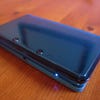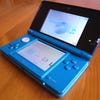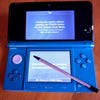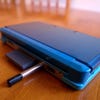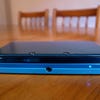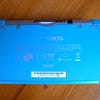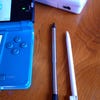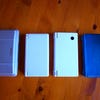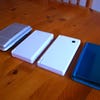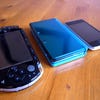European Nintendo 3DS Reviewed
The Eurogamer verdict.
The 3DS
3DS has almost exactly the same dimensions as a DSi, the sleekest if not quite the smallest version of the clamshell handheld to date. It's a little thicker and very slightly heavier, but it's still an extremely pleasing form factor which balances compactness and comfort well.
There's been a radical change in styling, though. The DSi, with its clean lines and velvety matte finish, was minimalist and discreet. The 3DS is futuristic, flashy and slightly fussy, with a bevelled lid that bulges outward and a three-tone finish: plain gloss underneath, a deeper, sparkly gloss around the lower screen, and an even darker and deeper gloss on the lid that's almost mirrored.
In the vivid, turquoise-tinted Aqua Blue, it's attention-grabbing to the point of being loud and tacky; the black edition (actually more of a charcoal grey) is more subtle. It picks up fingerprints easily, but they're equally easily wiped away – and although it looks like it will scratch if you so much as look at it askance, we've yet to damage ours, despite chucking it unprotected in a bag.
You're not going to mistake 3DS for an Apple or Sony product, and it frankly doesn't have the sleek sex appeal most tech gadgets costing over £200 strive for. But it doesn't feel cheap, either. As you would expect from Nintendo, the materials and build quality are superb, and every action, from the buttons to the snap of the lid, has a pleasing solidity to it. It's clearly a tough little machine that will be easy to develop an affection for.
Many of the controls are familiar from previous versions of DS. The stand-out, of course, is the new "circle pad", a loosely-sprung analogue slider with a concave top and long travel that sits under your thumb. It's very smooth and precise, and even for menu control it's hard to imagine using the now-awkwardly placed and rather redundant d-pad. There's also a new stylus, a metal telescopic number similar to the after-market ones available for current DS models. It now lives in the back of the machine, next to the game card slot. Longer and slimmer than the DSi's stylus, it's great to use.
Game cards are identical to the DS' slim plastic cartridges, apart from a protruding notch (presumably so you can feel the difference in your pocket). We can confirm that the software is locked by region; inserting one of our Japanese 3DS games into our European machine produces no result at all – it's as if no card has been inserted. This remains a deeply disappointing decision for handheld devices which will be taking a lot of long-haul flights. (However,our European and Japanese 3DS consoles were able to swap data via StreetPass.)
The unit bristles with half a dozen bright, coloured LEDs indicating power and battery status, operation of the camera, wireless and 3D features and so on. Sound has been improved; the twin speakers don't offer much in the way of bass, naturally, but they're loud, bright and clear, totally free of distortion and capable of a quite eerily convincing "surround" effect.
The lower, touch-sensitive LCD screen is very similar to the DSi's, and with its slightly soft coating is still much better suited to stylus than finger input. The star of the show is of course the upper 3D screen, now in widescreen ratio and set into a black surround to highlight the depth effect. The inclusion of a slider to adjust the strength of the 3D is a typically Nintendo stroke of genius, allowing you to find a setting that's comfortable, turn 3D off easily as and when you prefer, and simply fiddle around with 3DS' marquee feature.
As for that feature, we urge you to try before you buy. Not everyone can see the 3D effect comfortably; on the other hand, some who struggle with 3D using glasses at the cinema are happy to discover that they perceive 3DS' effect just fine. If you wear spectacles, you might find that removing them improves or 'smooths out' the 3D effect, so bear that in mind. Also, it's not recommended for children below the age of six (you can adjust 3D access in the machine's parental settings).
You can only see 3D properly, without any ghosting or double vision, within a very narrow, absolutely head-on viewing angle. 3DS being a handheld, this isn't a great problem, but surprisingly fine movements of your head or the console in your hands can throw the image out of whack. After a while you find yourself adjusting for this unconsciously, but to begin with it can be quite frustrating and finicky.
Line it up right and the effect isn't startling, but it is deeply impressive – and "deep" is the word. Although items in the foreground seem to protrude from the screen a little, mostly the image appears to recede into the distance, and in games with a long perspective camera – racers, for example – it's very involving. Even the gentle layering in menus is lovely to behold. But 3DS handles those dramatic "out of the screen" moments much less well, the image fracturing easily in the extreme foreground.

